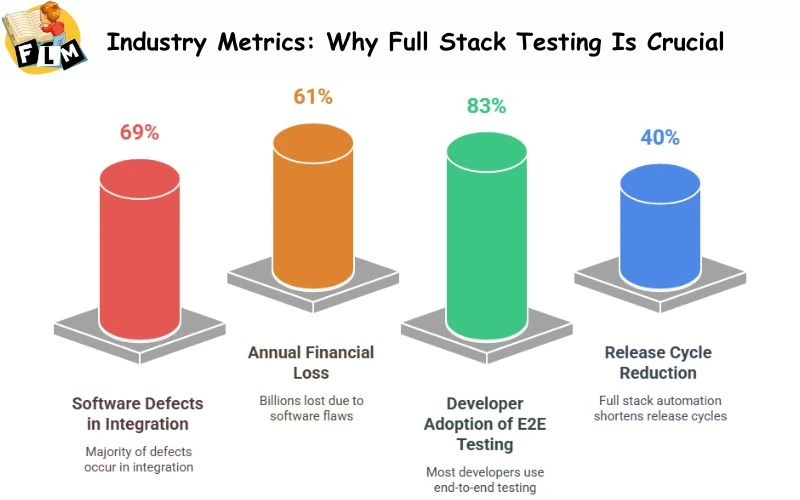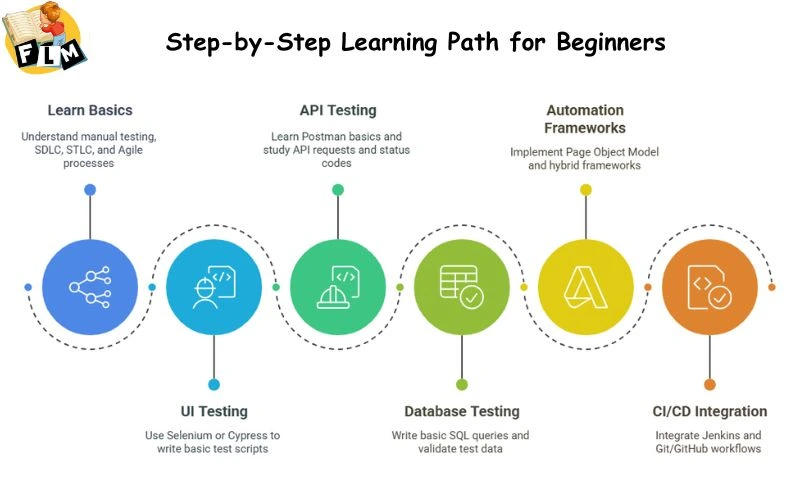In today’s rapidly evolving software development landscape, testing just one aspect of an application is not sufficient anymore. Apps these days are complex, multi-faceted, and interconnected across various systems. That is where Full Stack Testing steps in a robust strategy that tests all aspects of the application, from the front-end interface to the back-end databases and all the intermediary layers in between.
This is an ultimate beginner’s guide to getting full stack testing, why one needs it, what tools one uses, what skills one needs, and how it can benefit one’s career in the world of software testing or DevOps.
Let’s break it all down in simple, beginner-friendly English.
What Is Full Stack Testing?
Simple Definition
It means testing all levels of an application, the front end (UI), back end (server/database), APIs (interfaces), and third-party integrations to guarantee the app is functioning properly from top to bottom.
In other words, it is the equivalent of inspecting a machine from the outside case, internal cables, to how it plugs into other machines, and ensuring that all parts function flawlessly.
Layers Involved in Full Stack Testing
- FrontEnd (UI): What the user sees (HTML, CSS, JavaScript)
- BackEnd (Server/Logic): Where the data is processed (Java, Python, Node.js)
- Database: Where data is held (MySQL, MongoDB)
- API Layer: How the backend and frontend talk (REST, GraphQL)
Dreaming of a High-Paying career in tech?
Start learning online with Frontlines Edutech where Java, Python, Testing, and more are made simple and beginner-friendly!
Begin your journey today and turn your dreams into success.
Industry Metrics: Why Full Stack Testing Is Crucial

Let’s incorporate some real-world industry numbers to realize why full-stack testing is important:
- 69% of software defects occur in the integration stage, rather than in separate components. (IBM Research)
- $61 billion/year is lost by companies due to software flaws and application failures. (Tricentis)
- 83% of developers today use end-to-end testing strategies (Stack Overflow Developer Survey 2024)
- Full stack QA automation cuts release cycles by 40%, enhancing time to market.
These statistics illustrate the way that full stack testing is not only a best practice, it’s business essential in the age of digital.
Types of Testing in Full Stack Testing
To carry out full-stack testing, testers must cover various types of testing in all layers:
Unit Testing
- Tests individual functions/methods of code.
- Typically done by developers.
- Tools: JUnit, TestNG, Mocha
Integration Testing
- Verifies how various modules (frontend, backend, APIs) interact.
- Tools: Postman, REST Assured, SoapUI
UI Testing
- Verifies the frontend (look, feel, usability).
- Tools: Selenium, Cypress, Playwright
API Testing
- Tests how systems interact.
- Tools: Postman, Swagger, Karate
Database Testing
- Verifies stored data and queries.
- Tools: SQL, DbFit, Flyway
Performance & Security Testing
- Checks speed, load, and vulnerability.
- Tools: JMeter, OWASP ZAP
Tools Used in Full Stack Testing
A proper full stack testing setup requires a mix of tools:
| Layer | Tools |
| Front-End | Selenium, Cypress, Playwright |
| Back-End | JUnit, TestNG,REST Assured |
| API | Postman, SoapUI, Swagger |
| Database | MySQL, MangoDB, DbFit, Flyway |
| Performance | Apache, JMeter, LoadRunner |
| Security | OWASP ZAP, Burp Suite |
These tools are used together to build an automated testing pipeline that covers the entire stack.
Key Benefits of Full Stack Testing
End-to-End Coverage
All are tested UI, logic, data flow, and system integrations.
Faster Release Cycles
Early detection of bugs in each layer saves debugging time and accelerates development.
Cost Savings
Early bug fixes save up to 30% of costs.
Higher Test Accuracy
Unit, integration, and system-level testing together boost confidence in app stability.
Enhanced User Experience
You make sure that users don’t encounter broken links, missing information, or crashes.
Skills Required for Full Stack Testers
A full-stack tester should be a multi-skilled professional. Here’s what you need to learn:
Technical Skills
- HTML, CSS, JavaScript (basic frontend)
- API testing (Postman, REST principles)
- SQL and database knowledge
- Java/Python for automation scripting
- Git and CI/CD tools (Jenkins, GitHub Actions)
Soft Skills
- Analytical thinking
- Eye for detail
- Understanding of SDLC and Agile
- Collaboration with developers and product teams
Full Stack Testing in Real Companies
Most leading organizations in India and the world use full-stack testing:
- Amazon deploys full-stack automation suites to CI/CD pipelines.
- Infosys educates testers in full-stack methodologies on client projects.
- Wipro, Cognizant, and TCS expect testing skills in recruitment advertisements.
- Startups also favor testers who know how to address both API and UI layers.
Job Trends
As per Naukri.com and LinkedIn:
- Jobs referring to “Full Stack Testing” have grown 58% year over year.
- Average pay packages vary from ₹3 LPA (for freshers with primary skills) to ₹18 LPA.
Step-by-Step Learning Path for Beginners

If you’re just starting out testing or moving from manual testing, here’s the plan:
Learn Basics
- Manual Testing
- SDLC, STLC
- Agile process
UI Testing
- Selenium or Cypress
- Write basic test scripts
API Testing
- Postman basics
- Study API requests, status codes, and parameters
Database Testing
- Write basic SQL queries
- Validate test data
Automation Frameworks
- Page Object Model (POM)
- Hybrid/Data-driven frameworks
CI/CD Integration
- Jenkins
- Git and GitHub workflows
You will be prepared for testing projects and job positions by the end of this path.
Career Roles for Full Stack Testers
The most common job names for full-stack testing are listed below:
- Full Stack QA Engineer
- Automation Test Engineer
- SDET (Software Development Engineer in Test)
- DevTestOps Engineer
- Quality Analyst – Full Stack
Companies which Hire
- TCS, Infosys, Capgemini
- Accenture, Cognizant
- Zensar, Mindtree
- SaaS start-ups and product companies
Final Thoughts
In the modern tech world, testing doesn’t mean merely clicking buttons or checking login pages. It’s about knowing how all the pieces of the application fit together and ensuring they coexist harmoniously.
As businesses move towards Agile, DevOps, and automation-first strategies, the need for full-stack testers is increasing at a very fast pace. If you are a student, fresher, or working professional seeking upskilling, learning full-stack testing will provide you with a strong advantage in the IT job market.
Launch Your Career with Frontlines Edutech’s Full Stack Testing Online Course
Why Join?
- No coding needed – beginner-friendly
- In-demand QA skills with ₹5–12 LPA salary potential
- Complete testing journey in one course
Course Starts: 2nd June 2025
Timings: 8:00 PM – 9:00 PM (Live Daily)
Duration: 4 Months | Language: Simple Telugu
What You’ll Learn:
- Manual Testing + Agile + SQL
- API Testing with Postman
- Selenium Automation with Java
- DevOps: Git, Jenkins & CI/CD
This Course Includes:
- 10+ Real-Time Projects
- Resume & Interview Support
- Daily Assignments & Downloadable Notes
- Course Completion Certificate
Unlock your future with FLM’s Full Stack Testing Course
Limited Seats Only – Enroll Now!
Visit: frontlinesedutech.com | Click Here to Enroll
WhatsApp: 8333077727

